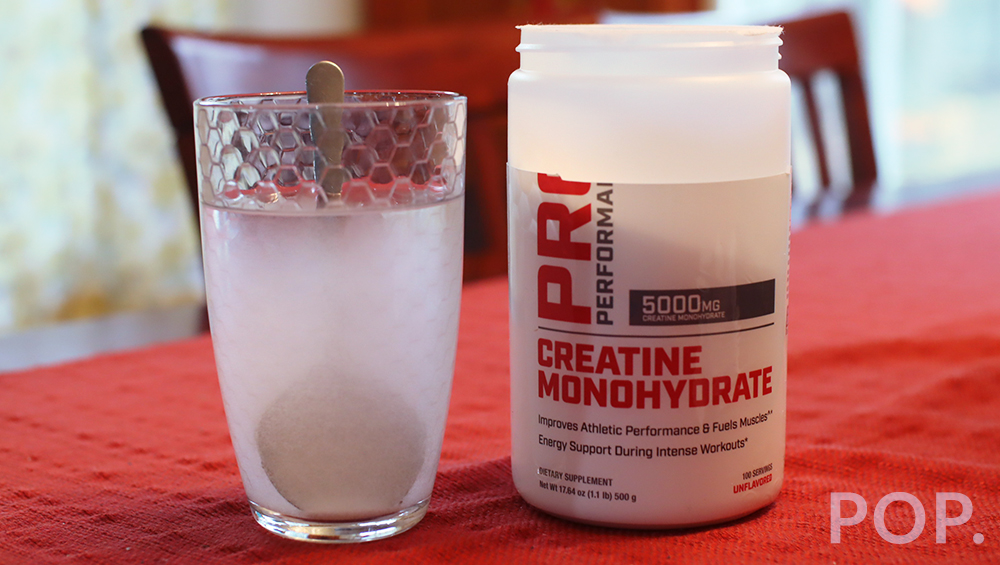Creatine is one of the most popular fitness supplements and is typically used by bodybuilders, athletes, and people training to increase strength and muscle mass. It is generally regarded to be safe for consumption, but there are common side effects that have been reported. One common side effect is creatine bloating.
Creatine bloating is a typical side effect that accompanies creatine consumption. It is characterized by increased water retention in the body (particularly in the skeletal muscles), and can even cause gastrointestinal distress (e.g., intestinal bloating). Creatine bloating does not occur in all creatine users and there are ways to prevent it from occurring.
This article will discuss the basics of creatine, what creatine bloating is, what causes it, and how to avoid it.
What is Creatine?

Creatine is an organic compound that is naturally produced in the body (specifically the liver, kidneys, and pancreas).
Creatine can also come from your diet. A hundred grams of food such as meat, fish, or poultry can have around 0.5-1.0 grams of creatine. While cooking can degrade the creatine into creatinine, food sources can account for approximately 1-2 grams of daily creatine intake.
Creatine is involved in one of the processes that produce ATP (adenosine triphosphate), the major energy currency in the body. Inside the mitochondria, a working cell uses ATP for various cellular processes and when used up, ATP is reduced into ADP (adenosine diphosphate). There are a few ways the cell can generate more ATP, but one way is to use creatine to recycle ADP back into ATP.
Thus, supplementary creatine can boost muscle workload, enhance muscle fiber size, increase lean body mass, and help prevent tissue damage.
Is Creatine Safe?
Creatine has been heavily scrutinized regarding safety for around two decades. It has been labeled as unsafe. Around the early 2000s, creatine monohydrate was deemed unsafe by the Scientific Committee on Food (SCF) despite insufficient evidence.
Throughout the years, more and more assessments were done and eventually, it was validated by several food safety agencies (e.g., European Food Safety Authority, French Agency for Food, Environmental and Occupational Safety Agency, Norwegian Scientific Committee for Food Safety, etc.).
Numerous studies have assessed the risk of creatine supplementation (especially creatine monohydrate) through so many different physiological parameters such as body mass, water, and hormones.
The International Society of Sports Nutrition published an official stand regarding the safety of creatine. Their paper cited countless studies proving that creatine not only enhances physical performance, but also helps to prevent or reduce instances of injury, enhance rehabilitation from injury, and increase tolerance to heavy workloads. They also highlight studies showing how safe creatine is from short-term (around 30 days) to long-term (up to five years) of consumption.
Creatine is also being investigated for clinical applications and other use cases in neurodegenerative diseases such as muscular dystrophy, Parkinson’s, and Huntington’s. It is also being studied for diabetes, fibromyalgia, aging, and adolescent depression.
Now, despite some reports of a few minor side effects such as creatine bloating, muscle cramping, diarrhea, and nausea, creatine is generally accepted to be safe for consumption.
What is Creatine Bloating?
Creatine bloating is a common reported side effect from taking creatine supplements. Bloating can cause an unpleasant feeling for people suffering from it.
Aside from the muscles, creatine bloating can extend to the gastrointestinal tract as intestinal bloating. Numerous individuals have reported the unpleasant feeling of gas in their stomach due to creatine consumption.
This phenomenon can be highly attributed to the ability of creatine to increase water retention. Water retention is the ability of the body to hold or accumulate water.
A 2003 paper published in the Journal of Athletic Training looked at sixteen men and divided them into two groups: the treatment group and the placebo group. The study clearly found that total body water was significantly increased in the group taking creatine.
Studies suggest that the increase of water retention is because creatine increases metabolic activity in the muscles, therefore the body sends more water to the muscles.
Furthermore, the chemical structure of creatine when mixed with water causes a hydration shell, causing a molecule of creatine to be surrounded by a cluster of water molecules.
While creatine bloating is among the more common side effects being reported, many creatine users also report to never have experienced creatine bloating or any other kind of side effects.
How to Avoid Creatine Bloating
There has been numerous studies and anecdotes regarding how to avoid creatine bloating. However, there has not been a single method that has been known to work for everyone. This can be attributed as the effects (and therefore the side effects) of creatine is highly dependent on the individual.
Dosage and Loading Phase
Some people have suggested that creatine bloating only occurs during the loading phase, the initial phase of taking creatine wherein a significantly higher dose is taken compared to the maintenance dose required to keep the muscles saturated with creatine.
The loading phase requires an individual to take around 20 grams per day for around five to seven (5-7) days. The loading phase safely speeds up the time it would take the muscles to get saturated with creatine. After the loading phase, a daily dose of three to five (3-5) grams is needed for maintenance.
Nonetheless, you can always skip the loading phase. With creatine monohydrate, it has been studied that a person can take the daily maintenance dose for 28 days to achieve the level of saturation that the loading phase will achieve.
The loading phase can also be skipped depending on the type of creatine used. Creatine hydrochloride (HCL) for example does not require a loading phase.
Beyond skipping the loading phase, it is also highly recommended that each person experiment with their daily maintenance dose. The recommend dose for maintenance is a range depending on the manufacturer (typically three to five grams).
However, a 2008 paper published in Research in Sports Medicine studied the effects of dosage on the side effects of creatine supplementation and found evidence to support that the dosage affects an individual’s feeling bloated.
Change your Creatine

There are a number of different types of creatine available. While the most common and widely used is creatine monohydrate, there are other forms of creatine with varying chemistries such as creatine HCL, creatine malate, creatine citrate, and many more.
Other people suggest using buffered creatine monohydrate, or Kre-Alkalyn. Buffered creatine is simply creatine mixed with an alkaline agent such as soda ash, magnesium glycerol phosphate, or bicarbonate. This increases the pH of the supplement to become more basic. It is advertised to be able to help reduce “bloating, cramping, and other side effects associated with traditional creatine supplementation.”
However, a 2012 paper published in the Journal of the International Society of Sports Nutrition looked into these claims and found no evidence to support that buffered creatine can reduce these side effects.
Lifestyle Choices
There are also lifestyle choices that have been suggested to reduce the occurrence of creatine bloating. It has been recommended that a diet with less salt (sodium) can help reduce creatine bloating as salt also plays a role in water retention.
It is also recommended to drink more water. While sounding counterintuitive, water retention caused by creatine bloating is concentrated in the muscles. Therefore, drinking more water ensures that there is enough water for the rest of the body.
It's Also Normal
While it is a side effect, creatine bloating is one sign that your creatine supplement is working. With consistent creatine consumption, training, and healthy diets, creatine bloating will lessen over time and eventually disappear.
However, if creatine bloating is an issue for an upcoming event, the quickest way to remove it is to stop taking creatine. The daily dose of creatine is just enough to maintain creatine saturation in the muscles and quickly disappear as soon as you stop.
While this is an option, it should be noted that stopping creatine supplementation will only stop creatine bloating as a band-aid solution and resuming creatine supplementation can bring back the bloating.

